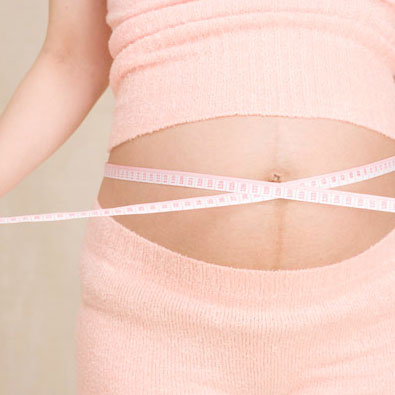First-time Bodily Changes

You're starting to look pregnant!
Once you enter the second trimester, changes that can be seen from outside the body begin to occur, and you'll begin to feel more keenly that there's a baby in your belly!
Feeling happy about your belly sticking out is something you can only enjoy during pregnancy, after all.
So enjoy that happiness to the fullest!
Will I definitely get stretch marks?
Stretch marks are welt-like lines that form on the belly or breasts as those areas grow bigger.
They sometimes form suddenly in the third trimester or when the pregnancy is full-term.
So why do stretch marks form?
What causes stretch marks?
When your belly or other areas rapidly grows bigger, the subcutaneous tissue on the outside cannot keep up with the speed at which the muscles and fat are increasing, and it may tear, causing stretch marks. Depending on your build and physique, it's not definite that you'll get them. Petite women or those who gain weight rapidly in a short period of time are more likely to get them.
Stretch marks do not hurt, but some people do feel itchy. They have no effect at all on the baby inside your belly, but it is said that once they form they never go away completely. So take a practical approach and tell yourself, "Having stretch marks is proof that I'm a mama!" Or if you're uncomfortable about marks remaining on your skin, preventing them is your best plan.
To prevent stretch marks
To prevent stretch marks before they are formed, the following 2 points are important.
●Watch your weight gain
To keep from gaining weight rapidly in a short time after the first term of pregnancy, it's best to be attentive about weight management. To ensure that the baby in your belly grows up healthy, and to keep your weight gain at a normal level, be mindful about controlling calories.
●Moisturize skin with cream, etc.
Stretch marks are a form of skin problem. To prevent skin problems, the basic remedy for the belly is "moisturizing," just as with the face. After your bath or when caring for your face in the morning, for example, rub some moisturizing cream on your belly, too, and gently massage it in. If you keep your skin hydrated and in a flexible condition, when your belly grows bigger the skin will stretch flexibly, warding off stretch marks. Creams specifically made for preventing stretch marks are also available, so try some.
Stretch marks often form on the lower part of the belly, which can be difficult to see for yourself in the third trimester, so the key is to moisturize your entire belly.
If stretch marks form
Once stretch marks form, it is said that they never go away completely. However, those that are reddish-purple during pregnancy will turn whitish after birth and gradually fade.
Even after stretch marks have formed, if you continue rubbing moisturizing cream on and massaging it in, you can prevent them from getting darker, so it's important not to give up!
When do changes begin to take place in the breasts?
Some women's nipples become sensitive as a sign of pregnancy.
And with pregnancy, the nipples and areolas sometimes become darker.
Even though no breast milk comes out during pregnancy, the breasts grow larger.
Let's take a look at the curious changes that take place involving the breasts.
Changes in the first trimester
The changes in the nipples and areolas appear in many cases as a sign of pregnancy. That means it's a delicate area that begins to change immediately after a pregnancy begins.
The changes in the nipples and areolas that appear as signs of pregnancy are as follows.
●Increased sensitivity
When your nipples touch your undergarments or clothing, you may feel uncomfortable or notice a tingling or stinging feeling. That can be attributed to the mammary glands beginning to develop.
●Color gets darker
Due to changes in the hormone balance caused by pregnancy, melanin pigmentation increases, and the nipples and areolas get darker.
*By this time (within the first 15 weeks of pregnancy), be sure to have an ultrasound done to check for breast cancer!
Changes from the second to third trimesters
The breasts gradually grow larger. If you're wondering why the breasts grow bigger even though no breast milk comes out during pregnancy, it's because the mammary glands develop rapidly and, just like in the entire body, fat increases. The changes in the breasts during this time are as follows.
●The breasts grow larger
As the breasts grow larger, stretch marks may form on them, just like they do on the belly. So it's a good idea to use moisturizing cream or other skin care on the breasts as well.
●Breast fluid may come out
Due to the development of mammary glands, if the nipples are stimulated, a small amount of breast fluid (a milky white-colored secretion) may come out.
How do I care for the breasts (nipples)?
The milk that comes from the breasts serves as the best source of nutrition for the baby.
In order to be able to smoothly begin breastfeeding after birth, it is important to care for the nipples and areolas during pregnancy.
Why is care important?
After birth, mama's breasts naturally swell with breast milk, but how it comes out varies from one mama to the next. Some reasons for the differences in how it comes out are differences in the shapes of nipples and how open the mammary glands (milk ducts) are.
The shapes of nipples vary from person to person. But some shapes are easy for babies to suck from and others are not. If the nipple is inverted or flat, it is difficult for the baby to suck from it.
Condition of the mammary glands and milk ducts
If the mammary glands or milk ducts are clogged, breast milk has trouble passing through and may have difficulty coming out.
Care for the nipples and areolas
In order to get the breasts into a condition where it is easy for the baby to suck and for breast milk to come out, try massaging the nipples and areolas beginning when you enter the stable period in the second trimester of pregnancy (around the 20th week). Also, there are devices available for correcting inverted or flat nipples.
*However, the body is delicate during pregnancy. The stimulus of massaging may prompt the belly to be strained, so before massaging or using a device, be sure to get the advice of your doctor or midwife.
●Nipple massage
Massaging the nipples or areola is effective after taking a bath, as the skin is soft then.
・Hold the breast with one hand, and using the fingers of the other hand, squeeze the breast from the areola area and massage it a little at a time, left and right.
・Once the areola area is soft, relax it by squeezing out toward the nipple.
・Squeeze the nipple and lightly pull it out.
*Before starting to massage the nipples or areola, make sure hands and breasts are clean.
Also, your belly may become strained when you stimulate the nipples; if that happens, stop immediately.
Why is weight management necessary?
Once you pass the morning sickness period, you'll get hungry more than you did before pregnancy.
But "eating for 2" is an old wives' tale.
Today when we have an abundant food life, an appropriate amount and a nutritional balance are important.
What's the breakdown of the weight gain?
If the baby weighs around 3kg at birth, why do I gain more weight than that?
The weight gain during pregnancy is all for a reason, and the breakdown is said to be as follows.
●Weight of the fetus→about 3kg
●Weight of the placenta→about 0.5kg
●Weight of the amniotic fluid→about 0.5kg
●Weight of the uterus, breasts, and blood, which increases during pregnancy→about 4kg
If you total all the above, it comes to about 8kg.
In addition to this, there's an accumulation of fat and fluids, which increases due to changes in the hormone balance caused by pregnancy.
What is wrong with gaining too much weight?
Some of the adverse effects of weight gain are as follows.
●It makes complications during pregnancy such as pregnancy induced hypertension and gestational diabetes more likely to occur.
●It may cause weak labor during delivery.
●If too much fat accumulates, the birth canal may become narrow or the baby may grow too big, which tends to lead to a difficult delivery.
Too little weight is also a problem
On the other hand, there has been an increase in recent years of mamas whose weight does not increase enough during pregnancy.
The idea of "birthing small and raising large" is an easy delivery myth. If you restrict weight gain in the extreme, it may cause the baby to be born with a low birth weight (under 2,500g).
An appropriate level is important for everything, so you'll want to take care not to get too desperate about weight management and restrict even the necessary nutrients.
How can I maintain the appropriate weight during pregnancy?
Now let's take a look at specific weight management.
The key is that meals should focus more on balance than amount.
Plus moderate exercise!
What is the full-term target weight increase?
The guidelines set forth in 2006 by the Ministry of Health, Labour and Welfare for recommended weight gain during pregnancy are as follows.
This is categorized according to a classification for physique called BMI (Body Mass Index).
●Thin women (BMI = less than18.5)→9-12kg
●Average women (BMI = 18.5-less than 25)→7-12kg
●Overweight women (BMI = 25 or higher)→Case by case (goal is around 5kg)
*BMI is calculated as "Weight (kg) ÷ Height (m)2."
How can I manage my weight appropriately?
Weigh yourself frequently
Just like when you're not pregnant, the most important thing in weight management is knowing your current condition. Step on a scale regularly, at least once a week, and record the changes in your weight. If possible, make a graph and stick it up where you can see it.
Don't gain more than 300g in 1 week
The amount that is OK to gain in one week is 300g at the most. If you've gained 500g or more, you need to be careful. Those who feel like checking that closely is too difficult can manage their weight with the rough goal of 1kg per month.
Once the morning sickness period is over, eat 3 meals per day and decrease snacks
Don't eat continuously between meals because you're hungry. As much as possible, try to get plenty of nutrients during meals.
For those who wait until their husband comes home late in the evening so that they can eat dinner together as a couple but feel "so hard holding out while waiting," it's recommended to divide 3 meals' worth of food into 4 meals. In late afternoon, have a light meal that's more like a snack, and then eat a lighter meal than your husband at dinnertime.
Think more about balance than amount
Sugar and fat lead to weight gain, so limit them. Salt can also cause pregnancy induced hypertension and cause you to eat too much staple foods, so limit it as much as you can. Balance is important both for the mommy's body and the baby, so try to get a feeling of fullness by eating lots of vegetables, and be mindful of your intake of protein, iron, and calcium.
Be mindful about getting moderate exercise
You'll be told that "pregnant women should rest," but you need moderate exercise. Walking has no negative effects for either the mama's body or the fetus, so once you enter the stable period, about an hour per day of a stroll or walking is recommended. Everyday housework is also OK, of course.
Lately there seems to be an increase in women who have an appropriate weight but lack muscle strength and thus experience a difficult delivery. Moderate exercise not only burns calories but also builds muscle strength, thus helping prepare for delivery.
Those who continue gaining weight despite walking and doing housework might want to try maternity swimming or maternity aerobics, for example, under the guidance of their doctor.
You may feel like "weight management is hard," but it's important in managing the health of both the mama and the baby.
If you tell yourself that "It's so that the precious baby in my belly can grow and be born healthy," and go about it together with the baby as if you were running a 3-legged race, won't weight management be fun?
update : 19.09.2017
Our favorites feature uses your browser's cookies. To use this feature, please enable cookies. If you are using Safari on your iPhone or iPad, please turn off the Private Browsing Mode. If you clear the cookie, you also clear the Favorite that you chose.


























